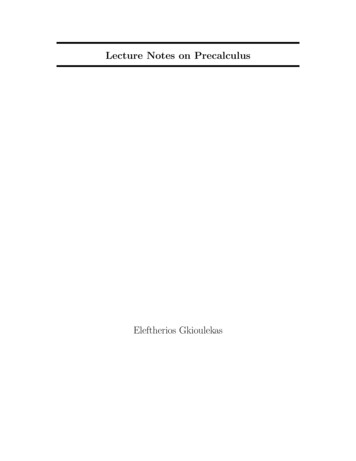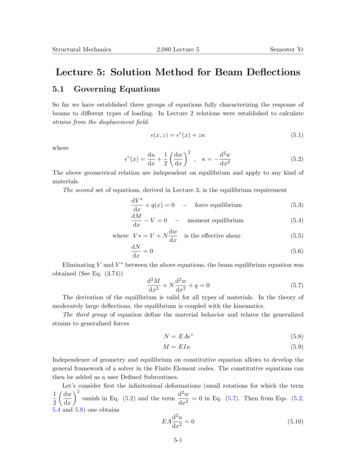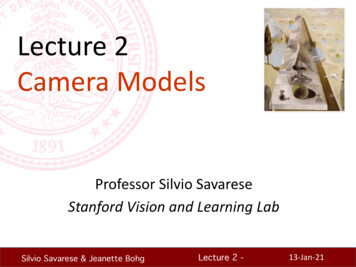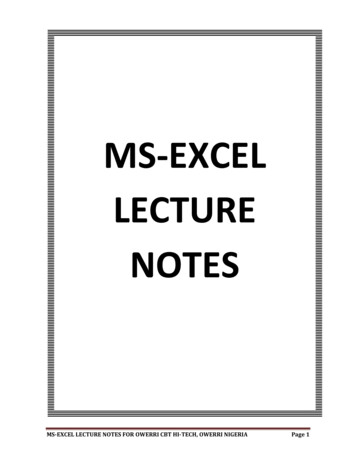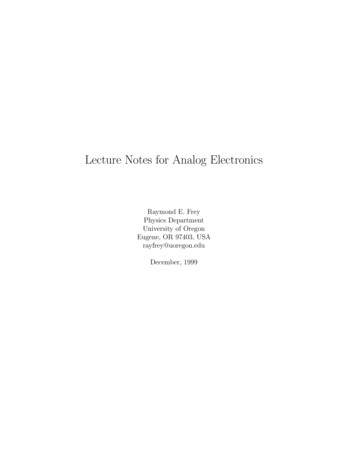
Transcription
Downloaded From Skyups Media AndroidApplicationSkyups MediaMECHANICAL ENGINEERING DEPARTMENTPower Plant EngineeringLecture NotesLECTURE NOTES
Downloaded From Skyups Media AndroidApplicationSkyups MediaPOWER PLANT ENGINEERINGLTPC3003OBJECTIVE: To understand the various components , operations and applications of differenttypes of power plantsUNIT I INTRODUCTION TO POWER PLANTS AND BOILERSLayout of Steam , Hydel , Diesel , MHD, Nuclear and Gas turbine Power PlantsCombined Power cycles – comparison and selection , Load duration Curves Steamboilers and cycles – High pressure and Super Critical Boilers – Fluidised Bed BoilersUNIT II STEAM POWER PLANTFuel and ash handling ,Combustion Equipment for burning coal, Mechanical Stokers.Pulveriser, Electrostatic Precipitator, Draught- Different Types, Surface condensertypes, cooling Towers99UNIT III NUCLEAR AND HYDEL POWER PLANTS9Nuclear Energy-Fission , Fusion Reaction, Types of Reactors, Pressurized water reactor,Boiling water reactor, Waste disposal and safety Hydel Power plant- Essentialelements, Selection of turbines, governing of Turbines- Micro hydel developmentsUNIT IV DIESEL AND GAS TURBINE POWER PLANTTypes of diesel plants, components , Selection of Engine type, applications-Gas turbinepower plant- Fuels- Gas turbine material – open and closed cycles- reheating –Regeneration and intercooling – combines cycle9UNIT V OTHER POWER PLANTS AND ECONOMICS OF POWER PLANTSGeo thermal- OTEC- tidel- Pumped storage –Solar central receiver system Cost ofelectric Energy- Fixed and operating costs-Energy rates- Types tariffs- Economics ofload sharing, comparison of various power plants.9TOTAL: 45 PERIODSTEXT BOOKS:1. Arora S.C and Domkundwar S, “A Course in Power Plant Engineering”, DhanpatRai, 20012. Nag P.K,”Power Plant Engineering”. Third edition Tata McGraw- Hill ,2007REFERENCES:1. EI-Wakil M.M, Power “Plant Technology,” Tata McGraw-Hill 19842. K.K.Ramalingam, “Power Plant Engineering “, Scitech Publications, 20023. G.R, Nagpal, “Power Plant Engineering”, Khanna Publishers 19984. G.D.Rai, “Introduction to Power Plant technology” Khanna Publishers, 1995
Downloaded From Skyups Media AndroidApplicationSkyups MediaUNIT-I INTRODUCTION TO POWER PLANTS AND BOILERSSTEAM POWER PLANT:A thermal power station is a power plant in which the prime mover is steam driven.Water is heated, turns into steam and spins a steam turbine which drives an electricalgenerator. After it passes through the turbine, the steam is condensed in a condenser andrecycled to where it was heated; this is known as a Rankine cycle. The greatest variation in thedesign of thermal power stations is due to the different fuel sources. Some prefer to use theterm energy center because such facilities convert forms of heat energy into electricity. Somethermal power plants also deliver heat energy for industrial purposes, for district heating, or fordesalination of water as well as delivering electrical power. A large proportion of CO2isproduced by the worlds fossil fired thermal power plants; efforts to reduce these outputs arevarious and widespread.
Downloaded From Skyups Media AndroidApplicationSkyups MediaThe four main circuits one would come across in any thermal power plant layout are-Coal andAshCircuit-AirandGasCircuit- Feed Water and Steam Circuit- Cooling Water CircuitCoal and Ash CircuitCoal and Ash circuit in a thermal power plant layout mainly takes care of feeding the boiler withcoal from the storage for combustion. The ash that is generated during combustion is collectedat the back of the boiler and removed to the ash storage by scrap conveyors. The combustion inthe Coal and Ash circuit is controlled by regulating the speed and the quality of coal enteringthe grate and the damper openings.Air and Gas CircuitAir from the atmosphere is directed into the furnace through the air preheated by the action ofa forced draught fan or induced draught fan. The dust from the air is removed before it entersthe combustion chamber of the thermal power plant layout. The exhaust gases from thecombustion heat the air, which goes through a heat exchanger and is finally let off into theenvironment.Feed Water and Steam CircuitThe steam produced in the boiler is supplied to the turbines to generate power. The steam thatis expelled by the prime mover in the thermal power plant layout is then condensed in acondenser for re-use in the boiler. The condensed water is forced through a pump into thefeed water heaters where it is heated using the steam from different points in the turbine. Tomake up for the lost steam and water while passing through the various components of thethermal power plant layout, feed water is supplied through external sources. Feed water ispurified in a purifying plant to reduce the dissolve salts that could scale the boiler tubes.Cooling Water CircuitThe quantity of cooling water required to cool the steam in a thermal power plant layout issignificantly high and hence it is supplied from a natural water source like a lake or a river. After
Downloaded From Skyups Media AndroidApplicationSkyups Mediapassing through screens that remove particles that can plug the condenser tubes in a thermalpower plant layout, it is passed through the condenser where the steam is condensed. Thewater is finally discharged back into the water source after cooling. Cooling water circuit canalso be a closed system where the cooled water is sent through cooling towers for re-use in thepower plant. The cooling water circulation in the condenser of a thermal power plant layouthelps in maintaining a low pressure in the condenser all throughout.All these circuits are integrated to form a thermal power plant layout that generates electricityto meet our needs.LAYOUT OF HYDEL POWER PLANT:Hydroelectric power plants convert the hydraulic potential energy from water into electricalenergy. Such plants are suitable were water with suitable head are available. The layoutcovered in this article is just a simple one and only cover the important parts of hydroelectricplant. The different parts of a hydroelectric power plant are
Downloaded From Skyups Media AndroidApplicationSkyups Media(1) DamDams are structures built over rivers to stop the water flow and form a reservoir.The reservoirstores the water flowing down the river. This water is diverted to turbines in power stations. Thedams collect water during the rainy season and stores it, thus allowing for a steady flow throughthe turbines throughout the year. Dams are also used for controlling floods and irrigation. Thedams should be water-tight and should be able to withstand the pressure exerted by the wateron it. There are different types of dams such as arch dams, gravity dams and buttress dams. Theheight of water in the dam is called head race.(2) SpillwayA spillway as the name suggests could be called as a way for spilling of water from dams. Itis used to provide for the release of flood water from a dam. It is used to prevent over toping ofthe dams which could result in damage or failure of dams. Spillways could be controlled type oruncontrolled type. The uncontrolled types start releasing water upon water rising above aparticular level. But in case of the controlled type, regulation of flow is possible.(3) Penstock and TunnelPenstocks are pipes which carry water from the reservoir to the turbines inside power station.They are usually made of steel and are equipped with gate systems.Water under high pressureflows through the penstock. A tunnel serves the same purpose as a penstock. It is used whenan obstruction is present between the dam and power station such as a mountain.(4) Surge TankSurge tanks are tanks connected to the water conductor system. It serves the purpose ofreducing water hammering in pipes which can cause damage to pipes. The sudden surge ofwater in penstock is taken by the surge tank, and when the water requirements increase, itsupplies the collected water thereby regulating water flow and pressure inside the penstock.(5) Power StationPower station contains a turbine coupled to a generator. The water brought to thepower
Downloaded From Skyups Media AndroidApplicationSkyups Mediastation rotates the vanes of the turbine producing torque and rotation of turbine shaft. This
Downloaded From Skyups Media AndroidApplicationSkyups Mediarotational torque is transfered to the generator and is converted into electricity. The usedwater is released through the tail race. The difference between head race and tail race is calledgross head and by subtracting the frictional losses we get the net head available to the turbinefor generation of electricity.DIESEL POWER PLANTDiesel power plants produce power from a diesel engine. Diesel electric plants in the range of 2to 50 MW capacities are used as central stations for small electric supply networks and used as astandby to hydro electric or thermal plants where continuous power supply is needed. Dieselpower plant is not economical compared to other power plants.The diesel power plants are cheaply used in the fields mentioned below.Peak load plants1. Mobile electric plants2. Standby units3. Emergency power plants4. Starting stations of existing plants5. Central power station etc.General Layout of Diesel power plantsGeneral Layout of Diesel power plants
Downloaded From Skyups Media AndroidApplicationSkyups Media
Downloaded From Skyups Media AndroidApplicationSkyups MediaFigure shows the arrangements of the engine and its auxiliaries in a diesel powerplant. The major components of the plant are:a) EngineEngine is the heart of a diesel power plant. Engine is directly connected through a gearbox to the generator. Generally two-stroke engines are used for power generation. Now adays, advanced super & turbo charged high speed engines are available for powerproduction.b) Air supply systemAir inlet is arranged outside the engine room. Air from the atmosphere is filtered by airfilter and conveyed to the inlet manifold of engine. In large plantssupercharger/turbocharger is used for increasing the pressure of input air whichincreases the power output.c) Exhaust SystemThis includes the silencers and connecting ducts. The heat content of the exhaust gasis utilized in a turbine in a turbocharger to compress the air input to the engine.d) Fuel SystemFuel is stored in a tank from where it flows to the fuel pump through a filter. Fuelis injected to the engine as per the load requirement.e) Cooling systemThis system includes water circulating pumps, cooling towers, water filter etc. Coolingwater is circulated through the engine block to keep the temperature of the engine inthe safe range.f) Lubricating system
Downloaded From Skyups Media AndroidApplicationSkyups Media
Downloaded From Skyups Media AndroidApplicationSkyups MediaLubrication system includes the air pumps, oil tanks, filters, coolers and pipe lines.Lubricant is given to reduce friction of moving parts and reduce the wear and tear ofthe engine parts.g) Starting SystemThere are three commonly used starting systems, they are;1) A petrol driven auxiliary engine,2)Use of electric motors,3)Use of compressed air from an air compressor at a pressure of 20 Kg/cm‖h) Governing systemThe function of a governing system is to maintain the speed of the engine constantirrespective of load on the plant. This is done by varying fuel supply to the engineaccording to load.Advantages of diesel power plants1. More efficient than thermal plant2. Design, Layout etc are simple and cheap3. Part load efficiency is very high4. It can be started quickly5. Simple & easy maintenance6. No problem with fuel & dust handling7. It can be located in the heart of town8. Less cooling water required.Disadvantages1. There is a limitation for size of a diesel engine2. Life of plant is comparatively less3. Noise pollution is very high
Downloaded From Skyups Media AndroidApplicationSkyups Media
Downloaded From Skyups Media AndroidApplicationSkyups Media4. Repair cost is very high5. High lubrication costNUCLEAR POWER PLANT:Nuclear power is the use of sustained nuclear fission to generate heat and douseful work. Nuclear Electric Plants, Nuclear Ships and Submarines use controlled nuclearenergy to heat water and produce steam, while in space, nuclear energy decays naturally in aradioisotope thermoelectric generator. Scientists are experimenting with fusion energy forfuture generation, but these experiments do not currently generate useful energy.Nuclear power provides about 6% of the world's energy and 13–14% of the world's electricity,with the U.S., France, and Japan together accounting for about 50% of nuclear generatedelectricity. Also, more than 150 naval vessels using nuclear propulsion have been built.Just as many conventional thermal power stations generate electricity by harnessingthe thermal energy released from burning fossil fuels, nuclear power plants convert the energyreleased from the nucleus of an atom, typically via nuclear fission.Nuclear reactor technologyWhen a relatively large fissile atomic nucleus (usually uranium-235 orplutonium-239) absorbs a neutron, a fission of the atom often results. Fission splits theatom into two or more smaller nuclei with kinetic energy (known as fission products) andalso releases gamma radiation and free neutrons.[59] A portion of these neutrons maylater be absorbed by other fissile atoms and create more fissions, which release moreneutrons, and so on.
Downloaded From Skyups Media AndroidApplicationSkyups MediaThis nuclear chain reaction can be controlled by using neutron poisons andneutron moderators to change the portion of neutrons that will go on to cause morefissions.[60] Nuclear reactors generally have automatic and manual systems to shut thefission reaction down if unsafe conditions are detected.Three nuclear powered ships, (top to bottom) nuclear cruisers USS Bainbridge and USSLong Beach with USS Enterprise the first nuclear powered aircraft c
Power Plant Engineering Lecture Notes LECTURE NOTES . Downloaded From Skyups Media Android Application Skyups Media POWER PLANT ENGINEERING OBJECTIVE: L T P C 3 0 0 3 To understand the various components , operations and applications of different types of power plants UNIT I INTRODUCTION TO POWER PLANTS AND BOILERS 9 Layout of Steam , Hydel , Diesel , MHD,


